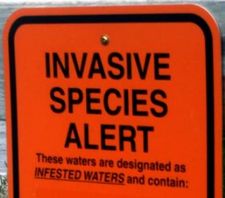Difference between revisions of "GCDAMP Invasive Species"
From Glen Canyon Dam AMP
(fix) |
(add invasive species wording) |
||
| Line 14: | Line 14: | ||
---- | ---- | ||
'''Definition:''' Plant or animal organisms that move into new areas (habitats) and take over are called '''invasive species'''. | '''Definition:''' Plant or animal organisms that move into new areas (habitats) and take over are called '''invasive species'''. | ||
| + | *Invasive species are harmful organisms that can explode in numbers, and potentially wipe out native wildlife and destroy habitats. | ||
---- | ---- | ||
Revision as of 12:11, 30 April 2014
| INVASIVE SPECIES- GCDAMP | |
 |
Definition: Plant or animal organisms that move into new areas (habitats) and take over are called invasive species.
- Invasive species are harmful organisms that can explode in numbers, and potentially wipe out native wildlife and destroy habitats.
LEGAL AND POLICY
- Executive Order 13112, Invasive species, directs federal agencies to use relevant programs and authorities to prevent introduction of exotic plant and aquatic invasive species; provide for their control; and minimize economic, ecological, and human health impacts invasive species cause.
- When new introductions of non-native fish species are encountered, depending on level of treat and magnitude of response needed, control measures may take place through Emergency Response procedures. To the extent possible, NPS would coordinate with other management agencies, tribes, and/or land owners in watersheds that extend beyond GCNP or GCNRA to evaluate risk of new introductions from those areas and develp cooperative efforts to dter future invasions. (NPS CFMP-EA_pg 33)
- NON-NATIVE FISH HISTORY Non-native fish species present in Grand Canyon were mostly established as a result of intentional stocking to develop sport fisheries in the Colorado River and its trivutaries during the late 1800s and early 1900s. Impacts of these actions was not fully understood until later in the 20th Cetury when a shift to native species conservation management occurred in the NPS. Negative impacts of non-native fish and altered habitats on native fish species has been well-documented throughtout the world. Over 20 non-native fish species have been documented in GCNP; However, the more common, large-bodied, species of management concern include rainbow and brown trout, common carp, channel catfish, and bullhead species, striped and smallmouth bass. These species are known predators on native fish or native fish eggs or compete with native fish species.(NPS CFMP-EA_Pg 62)
- The fish community throughout Marble Canyon, downstream of the Glen Canyon Reach is GCNP, is dominated by non-native rainbow trout. The fish community changes near the LCR inflow near RM 60 where native species begin to occur. (NPS CFMP-EA_Pg 63)
- Contributor: TBD
- Category: Ecosystem
